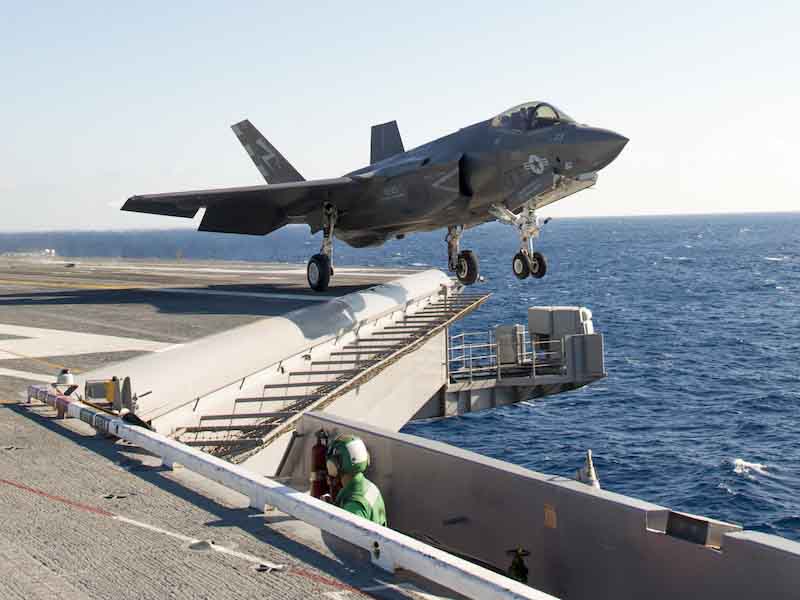Corrdesa in Tyrone, Georgia, is now under contract to supply an initial 50 units, with options for 40+ per year for the following three years to equip the growing number of F-35 squadrons around the world.
 Dr. Alan RoseDr. Alan Rose, CEO of Corrdesa, says the Dalistick plating/anodizing unit is designed as a closed-loop system that pumps electrolyte from the bottle through the plating tool where it repairs the aircraft and back into the bottle for clean, no-touch disposal when it is depleted.
Dr. Alan RoseDr. Alan Rose, CEO of Corrdesa, says the Dalistick plating/anodizing unit is designed as a closed-loop system that pumps electrolyte from the bottle through the plating tool where it repairs the aircraft and back into the bottle for clean, no-touch disposal when it is depleted.
Rose says the operator needs only clean, smooth, and measure the area to be repaired, glide the plating tool over the damaged area until the machine shuts off at the predetermined plating thickness, and apply a non-chromate passivate.
“The aircraft can then be non-chrome primed and painted and put back in the air, Rose says.
Lockheed Martin’s fifth-generation F-35 is not only considered the most advanced fighter aircraft in the world but also the greenest. It is designed and produced with mission readiness and the warfighter's success in mind, but at the same time, almost all cadmium, chromates, and other toxic materials have been eliminated from construction and maintenance.
 Corrdesa partnered with Dalic, France to produce the ruggedized, mobile Dalistick system for ZnNi plating repairs directly on aircraft.Toxic chromated cadmium for corrosion control has been replaced by clean, safe, and more effective chromate-free electroplated zinc-nickel (ZnNi). For new builds, this is done in large, commercial electroplating tanks, but when the coatings are damaged in the field, the on-aircraft repair is required for a quick turnaround without substantial disassembly.
Corrdesa partnered with Dalic, France to produce the ruggedized, mobile Dalistick system for ZnNi plating repairs directly on aircraft.Toxic chromated cadmium for corrosion control has been replaced by clean, safe, and more effective chromate-free electroplated zinc-nickel (ZnNi). For new builds, this is done in large, commercial electroplating tanks, but when the coatings are damaged in the field, the on-aircraft repair is required for a quick turnaround without substantial disassembly.
Over the past seven years, DoD funding from SBIRs and SERDP-ESTCP has helped Corrdesa to develop and qualify non-drip brush plating and anodizing repair processes, equipment, and tooling.
Partnering with Dalic, France, the Dalistick non-drip brush plating equipment has been tested and further developed to address repair challenges in the USAF, US Navy maintenance facilities, and aircraft carriers, which require a safe operation on deck at sea.
Brush plating is typically done in a hangar, where drips and spills of plating chemicals can be controlled, channeled, or at least wiped up to avoid exposing workers to harmful chemicals.
“But brush plating outside on the flight line or a pitching carrier deck is an entirely different proposition,” Rose says.
For that, the F-35Ground Support Equipment (GSE) plating systems are installed in custom-designed ruggedized carts, enabling repair directly on the aircraft in harsh conditions.
“Being able to repair the aircraft with non-drip, no-mess technology saves time and returns it to service as fast as possible,” Rose says.
Visit https://www.corrdesa.com
About Corrdesa: based in Tyrone, GA, Corrdesa uses Computer-Aided Engineering (CAE) simulation tools to develop corrosion-resistant coatings, processes, and equipment to meet customer needs and regulatory requirements such as REACH.
About DALIC: established in 1932 and based in Vitré, France, DALIC supplies a wide range of selective brush plating/anodizing products and services across many transports and industrial sectors.
SERDP-ESTCP: the Strategic Environmental Research and Development Program (SERDP) is DoD’s environmental science and technology program, planned and executed in partnership with DOE and EPA, with participation by numerous other federal and non-federal organizations. SERDP invests across a broad spectrum of basic and applied research, as well as advanced development. The Environmental Security Technology Certification Program (ESTCP) is DoD’s environmental technology demonstration and validation program. The Program was established in 1995 to promote the transfer of innovative technologies that have successfully established proof-of-concept to field or production use. ESTCP demonstrations collect cost and performance data to overcome the barriers to employ an innovative technology because of concerns regarding technical or programmatic risk, the so-called “Valley of Death.” https://www.serdp-estcp.org/
SBIR: the Small Business Innovation Research (SBIR) is a highly competitive awards-based program that encourages domestic small businesses to engage in Federal Research/Research and Development (R/R&D) with the potential for commercialization. By including qualified small businesses in the nation's R&D arena, high-tech innovation is stimulated, and the United States gains entrepreneurial spirit as it meets its specific research and development needs. https://www.sbir.gov/about































